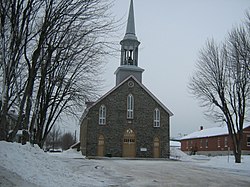
Saint-Tite is a Canadian city located at the foothills of the Laurentians, between Grandes-Piles and Saint-Adelphe, in the Mauricie RCM of Mékinac. A large body of water, Lake Pierre-Paul, bathes the northeastern part of the territory.'
Francheville was a former regional county municipality in the Mauricie region of Quebec, Canada. Prior to its dissolution, it had an area of 1,124 square kilometres (434 sq mi).
Le Centre-de-la-Mauricie was a former regional county municipality and census division in the Mauricie region of Quebec, Canada.

Mékinac is a regional county municipality (RCM) of 5,607 km2 located in the administrative region of Mauricie, along the Saint-Maurice River, which also crosses the RCM from one end to the other, and the Matawin River, a tributary of the Saint-Maurice. Located in the province of Quebec, Canada.

Les Chenaux is a regional county municipality in central Quebec, Canada, in the Mauricie region. The seat is in Saint-Luc-de-Vincennes. It is located adjacent on the east of Trois-Rivières on the Saint Lawrence River. It has a land area of 872.04 square kilometres (336.70 sq mi) and a population of 17,865 inhabitants in the Canada 2011 Census. Its largest community is the parish of Notre-Dame-du-Mont-Carmel.
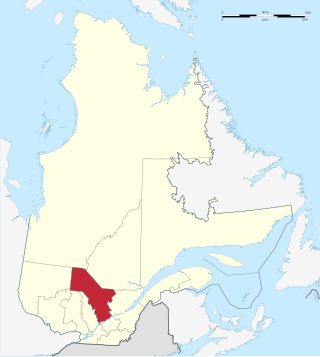
Mauricie is a traditional and current administrative region of Quebec. La Mauricie National Park is contained within the region, making tourism in Mauricie popular. The region has a land area of 35,860.05 km2 and a population of 266,112 residents as of the 2016 Census. Its largest cities are Trois-Rivières and Shawinigan.
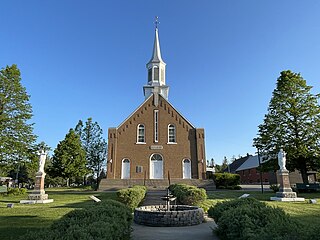
Notre-Dame-du-Mont-Carmel in the Mauricie region of the province of Quebec in Canada.

Saint-Séverin is a parish municipality in Quebec (Canada) in the Mékinac Regional County Municipality, Quebec, in the administrative region of Mauricie and watershed the Batiscanie. At various times, the place was also known as Saint-Séverin-de-Proulxville and Proulxville.
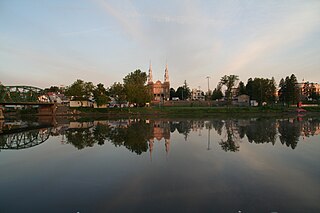
Saint-Stanislas, old name Deux-Rivières (Village), is a municipality part of Les Chenaux Regional County Municipality, in Mauricie, Quebec, Canada.

Hérouxville is a parish municipality in the Mékinac Regional County Municipality in the administrative region of Mauricie, in the province of Quebec, Canada. Its watershed is mainly part of the Batiscanie.
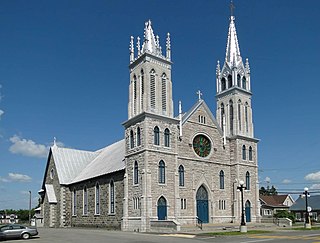
Saint-Narcisse is a parish municipality located in the regional county municipality (MRC) Chenaux, in the administrative region of Mauricie, in the province of Quebec, in Canada. Located on the North Shore of the Saint Lawrence River, about 30 km (19 mi) from downtown Trois-Rivières, the parish of Saint-Narcisse is the heart of the Mauricie region.

Lac-aux-Sables is a parish municipality in the Mékinac Regional County Municipality, in administrative district of the Mauricie region of the province of Quebec in Canada. Its population centres are Lac-aux-Sables and Hervey-Jonction.

Notre-Dame-de-Montauban is a municipality in the Mauricie region in Quebec, Canada. The municipality is on the northern edge of Mékinac Regional County Municipality and the administrative region of Mauricie and includes the population centres of Notre-Dame-des-Anges and Montauban-les-Mines. Both communities are located along route 367 and are about 7 kilometres (4.3 mi) apart.

Batiscan River has its source in the region of Lac Édouard, in the Laurentians Mountains, the Batiscan River flows over a length of 177 km. It receives water from numerous tributaries, including, in its upper reach, the Rivière aux Éclairs and the Jeannotte river. In its downstream part, it waters Saint-Narcisse and Sainte-Geneviève-de-Batiscan before flowing into the St. Lawrence River at Batiscan.
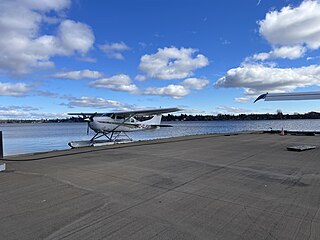
Lac-à-la-Tortue, is a sector of the city of Shawinigan since 2002, it is located in Mauricie, Quebec, Canada.
The use includes the Lac-à-la-Tortue sector in Batiscanie, the common name for the watershed of the Batiscan River.
Considered the cradle of commercial bush flying in Canada, the Lac-à-la-Tortue sector is home to the oldest civilian seaplane base in Canada.
Since the twentieth century, the area has been a well-known resort.
Mauricie tourism represents an important sector of Québec’s economy with 1.2 to 1.5 million visitors each year who spend 200 to 300 million dollars per year in tourist attractions and services. In 2011, 90% of tourists in Mauricie were Quebecers, 3% came from other Canadian provenances, 2% from the United States, and 4% from others.

The rivière à la Fourche is a tributary of the northwest bank of the Champlain River, flowing on the east side of the Saint-Maurice River and on the north side of the St. Lawrence River, in the Les Chenaux Regional County Municipality, in the administrative region of Mauricie, in province of Quebec, in Canada.

The rivière au Lard flows on 21.2 kilometres (13.2 mi) in the municipality of Notre-Dame-du-Mont-Carmel, then those of Saint-Maurice, Saint-Narcisse and Saint-Luc-de-Vincennes, in the Les Chenaux Regional County Municipality, in the administrative region of Mauricie, in Quebec, in Canada.

The Rivière Cachée is a tributary of the Saint-Maurice River, flowing on the north bank of the Saint Lawrence River, entirely in Notre-Dame-du-Mont-Carmel, in Les Chenaux Regional County Municipality (RCM), in Mauricie administrative region, in province of Quebec, Canada.
The Rivière aux Rouilles is a tributary of the Saint-Maurice River, flowing on the north bank of the Saint Lawrence River, entirely in the Lac à la Tortue from the city of Shawinigan, in the administrative region of Mauricie, in the province of Quebec, in Canada.
